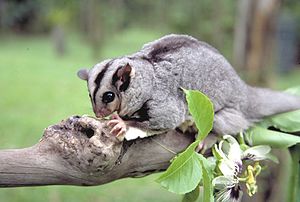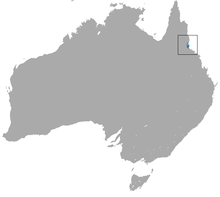Mahogany flying squirrel bag
| Mahogany flying squirrel bag | ||||||||||||
|---|---|---|---|---|---|---|---|---|---|---|---|---|

Mahogany flying squirrel bucket ( Petaurus gracilis ) |
||||||||||||
| Systematics | ||||||||||||
|
||||||||||||
| Scientific name | ||||||||||||
| Petaurus gracilis | ||||||||||||
| ( De Vis , 1883) |
The mahogany flying squirrel bucket ( Petaurus gracilis ) ( English Mahogany Glider ) is a very rare Australian marsupial from the genus of the flying squirrel bucket ( Petaurus ). Its range is limited to a small forest area on the coast of northern Queensland . This flying squirrel bag was lost for over a hundred years before the species was rediscovered in 1989.
features
The mahogany flying squirrel bag is similar to the more common medium-sized flying squirrel bag , but is much larger. The head body length is 22.5 to 27.5 cm, the tail is 33.5 to 40.5 cm long. Females have a longer tail than males in relation to their body length. Overall, however, males are on average larger and heavier than females. The weight of the males is 345 to 500 g, that of the females 310 to 450 g. The smallest and lightest representatives of this species are therefore still significantly larger than the largest and heaviest representatives of the Middle Gleithörnchenbeutler.
The fur of this flying squirrel bucket is gray, a black line of eel runs down its back. The fur on the sliding membrane can be beige, orange or mahogany brown.
distribution and habitat
The distribution area extends over a north-south distance of only 122 km along the Pacific coast of Queensland. The southern limit is the Ollera Creek (40 km south of Ingham ), the northern limit of the Hull River near Tully . In total, this is an area of 140,000 hectares.
The area is dominated by tall open forests . Petaurus gracilis only occurs at altitudes below 100 m.
Way of life
activity
Like all flying squirrel bucket, the mahogany flying squirrel bucket is a nocturnal animal. Under ideal conditions (natural forest) it occupies a large action area of around 20 hectares. In forest areas fragmented by roads and fields, however, it can be considerably less. He covers an average of 1500 m distance per night. Every two to three nights he completes a loop through his entire action area. In this area he uses three to nine burrows, namely knotholes and tree hollows, especially in eucalyptus trees and other trees from the myrtle family ; the entrance to these caves is 7 to 33 m above the ground and almost always faces south and west, which is usually the leeward side.
Males and females live in social monogamy . They largely share the same action space, but go foraging separately and often even sleep in different burrows. The separate way of life naturally offers the animals opportunities for reproduction with other partners; this probably explains the high level of aggressiveness with which these gliding squirrel conspecifics meet conspecifics of the same sex. Although the mahogany flying squirrel bucket prefers to live in pairs, there are also some male loners who inhabit a territory alone.
The mahogany gliding squirrel bucket lives in its area of distribution together with the more common short-headed gliding bucket . However, both species seem to prefer slightly different habitats: the short-headed gliding beech dense forest with a closed canopy, the mahogany gliding squirrel beetle more open forests. However, if both species collide, the short-headed glider is usually chased away.
In gliding flight, the mahogany flying squirrel bag can cover 30 m, up to a maximum of 60 m. It loses an average of 1 m in height for every 2 m glide.
food
Like other flying squirrel bucket, the mahogany flying squirrel bucket feeds on tree sap, nectar and pollen, as well as on invertebrates. Vegetable food makes up the greater part.
Reproduction
In the dry season between April and October, one or two young are born and grow up in the well-developed pouch. The average litter size is 1.55. The young are suckled for four to five months and are sexually mature after twelve to eighteen months. The lifespan is probably five to six years.
Enemies
The natural enemies of this flying squirrel bucket include the amethyst python , the red bush owl , the bark owl , the New Holland owl and the spotted soot owl . House cats introduced by humans can also prey on the species.
Systematics and names
The species was described in 1883 by Charles Walter De Vis , a naturalist and curator of the Queensland Museum . De Vis gave it the name Belideus gracilis , but failed to name a holotype . Since the species could not be found again, the validity of De Vis' description was questioned, and as early as the 19th century Belideus gracilis was classified as a synonym for Petaurus norfolcensis .
After not being seen for over a century, it was rediscovered on December 6, 1989. The status as an independent species was subsequently confirmed by the zoologist Steve Van Dyck. In the meantime it has been found out that the genetic differences between Petaurus gracilis and the mean gliding squirrel bucket are smaller than between different populations of the short-headed gliding bucket, nevertheless the species status has not yet been questioned.
Threat and protection
The IUCN classifies the mahogany petaurus because of its small geographic range and presumably decreasing inventory figures as endangered ( endangered one). The main threat is likely to be the ongoing destruction of the forests, as new sugar cane, banana and pineapple plantations, pastures, aquaculture and reforested pine forests are emerging there. Only 20% of the original habitat is still intact. The fragmentation of the habitat also means that populations are permanently separated from one another, as flying squirrel hives do not move on the ground. A favorable circumstance is that there are three national parks within the range: the Edmund Kennedy National Park , the Girringun National Park and the Paluma Range National Park .
In February 2011, cyclone Yasi hit the northeast coast of Queensland and wreaked havoc on the species' habitat. Attempts were then made to help the populations of the mahogany flying squirrel bucket with feeding stations and nesting boxes.
Individual evidence
- ↑ a b c d e Jackson 2011, p. 142
- ↑ Parsons 2012, p. 372
- ↑ a b Jackson 2011, p. 144
- ↑ a b Jackson 2011, p. 146
- ↑ a b c Jackson 2011, p. 145
- ↑ Jackson 2011, p. 143
- ↑ a b Queensland Government, Environment and Resource Management ( Memento of the original from April 15, 2012 in the Internet Archive ) Info: The archive link was inserted automatically and has not yet been checked. Please check the original and archive link according to the instructions and then remove this notice. , accessed February 19, 2012
- ↑ Jackson 2011, p. 141
- ↑ Petaurus gracilis in the IUCN Red List of Threatened Species . Retrieved February 18, 2012.
literature
- Stephen M. Jackson: Petaurus gracilis (Diprotodontia: Petauridae) . In: Mammalian Species 2011, No. 43, pp. 141-148
- Mark Parsons: Mahogany Glider . In: Queensland's Threatened Animals , Csiro Publishing 2012. ISBN 9780643096141
